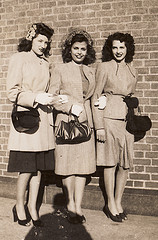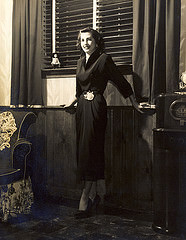Some of my mothers’ photographs on Flicker have been viewed 5,000 to 8,000 times. The only explanation is that old photos speak to each of us in different ways – whether we admire an era gone by or think of our own loved ones old photographs take us back to wonderful places.
I was thinking about what to write about this week when an old photo of my mother popped up on my Facebook wall. Much to her surprise, my cousin stumbled upon this photo in a Facebook group she follows: Manhattan Before 1990. Rheannone Rocha who blogs at New York City Vintage advised that this photo was one of her most popular posts. She found the photo on Flicker, where my mom, who never saw a computer, has gained a significant fan base thanks to my brother the keeper of photos and memories.
I can’t begin to explain what these photos mean to me, as I search for clues about myself I simultaneously feel she was someone I never knew, since she died so young, and the person who has had the most profound influence on my life. She was strikingly beautiful, resourceful, talented and creative. She made all of the clothes she wore in the photographs. We really aren’t sure who took these photographs, but believe it may have been my grandfather, the master tailor, who taught his girls how to sew. He was an immigrant who came to America with very little and no mastery of the English language. Although a pragmatic man he somehow saw the value in taking photographs.
The documenting of our lives is in a sense an attempt at preserving memories, dreams and our own immortality. Modern day technology allows us to constantly snap away from selfies to everyday events. The need, desire and value of photographing our lives are as pervasive as ever and the ability to share our lives through these images has expanded in ways unimaginable prior to the advent of the internet. Just take a look at Flicker to see the myriad of groups where every day people share their images. My brother is one of them; he’s also a very good photographer starting with a dark room when he was just a teenager. He serves as the family preservationist and catalogs the photos on his Flicker account. At first the photos were posted for family members but surprisingly they have attracted a following and the most viewed photos are of my mother. As a gifted seamstress, her photos often showcase a new outfit. The photos are emblematic of fashion in the 1940s. Prior to 1945, a utilitarian, although chic, look dominated the fashion scene. After the end of WWII, Hollywood’s Golden Age stars influenced fashions. My mother’s fashions are truly a study of the elegance of this time period.
According to my brother, “For a girl who never left the Bronx, her photos have gone everywhere: background for a PBS film, British Craft Magazine, logo for a Dutch Vintage Jewelry Store, YouTube music videos, Mother’s Day ad campaigns, and even the image for an urban renewal project in Covington, Georgia, and countless blogs. Sometimes I get letters from people who tell me they saw her; they recognized the dress. Dressmakers have copied her clothes and ask me for permission/advice. There is something special about these photographs from the 1940’s — an enthusiasm for life that seems to slowly disappear in the late 50’s and 60’s. Her photos are by far my most popular, especially in terms of referrers. I find them on lots of blogs; often in very funny juxtapositions, my mom and Marilyn Monroe, for instance. I often wonder what she would have thought of my publication of her photos. Our lives back then were lived on such a small stage: the kitchen, the living room, the backyard, the parish church and the neighborhood. That was it. Sometimes on weekends the one telephone, upstairs in my grandfather’s house, would ring, but he was rarely in the house to answer it. Always out in the garden. No one else dared touch it. So much for the whole wide world.”
























Leave a Reply